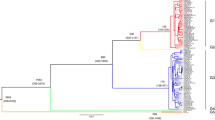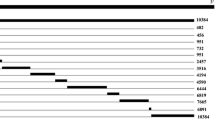Abstract
We determined the complete nucleotide sequence of a Japanese encephalitis virus (JEV) isolate (designated SH17M-2007) from a pool of Culex tritaeniorhynchus collected in southern China in 2007. The genome consisted of 10,965 nucleotides and included a single open reading frame (10,296 nucleotides) that encodes a 3,432-amino-acid polyprotein. The SH17M-2007 had 97.3 to 98.4% nucleotide identity with two Korean strains (KV1899, K94P05) and two Japanese strains (Ishikawa, JEV/sw/Mie/40/2004), but only 88.8% identity with the Chinese vaccine strain SA14-14-2. Five unique amino acid substitutions including one in the envelope (E) protein (GluE-306-Lys) were found in the SH17M-2007 strain. Phylogenetic relationships based on the full-length nucleotide sequences were similar to those based on the E gene.

Similar content being viewed by others
Abbreviations
- JEV:
-
Japanese encephalitis virus
- ORF:
-
Open reading frame
- NTR:
-
Non-translated region
References
Ali A, Igarashi A (1997) Antigenic and genetic variation among Japanese encephalitis virus strains belong to genotype 1. Microbiol Immunol 41:241–252
Chen WR, Tesh RB, Rico-Hesse R (1990) Genetic variation of Japanese encephalitis virus in nature. J Gen Virol 71:2915–2922
Chen WR, Rico-Hesse R, Tesh RB (1992) A new genotype of Japanese encephalitis virus from Indonesia. Am J Trop Med Hyg 47:61–69
Endy TP, Nisalak A (2002) Japanese encephalitis virus: ecology and epidemiology. Curr Top Microbiol Immunol 267:11–48
Kumar S, Tamura K, Nei M (2004) Mega 3: Integrated software for molecular evolutionary. Brief Bioinform 5:150–163
McMinn PC (1997) The molecular basis of virulence of the encephalitogenic flaviviruses. J Gen Virol 78:2711–2722
Nam JH, Chung YJ, Ban SJ, Kim EJ, Park YK, Cho HE (1996) Envelope gene sequence variation among Japanese encephalitis virus isolated in Korea. Acta Virol 40:303–309
Nam JH, Chae SL, Won SY, Kim EJ, Yoon KS, Kim BI, Jeong YS, Cho HW (2001) Genetic Heterogeneity of Japanese encephalitis virus assessed via analysis of the full-length genome sequence of Korean isolate. Am J Trop Med Hyg 65:388–392
Ni H, Barret ADT (1995) Nucleotide and deduced amino acid sequence of the structural protein genes of Japanese encephalitis viruses from different geographical location. J Gen Virol 76:401–407
Ni H, Barrett ADT (1996) Molecular differences between wild-type Japanese encephalitis virus strains of high and low mouse neuroinvasiveness. J Gen Virol 77:449–455
Takegami T, Ishak H, Miyamota C, Shirak Y, Kamiura K (2000) Isolation and molecular comparison of Japanese encephalitis virus in Ishikawa, Japan. Jpn J Infect Dis 53:178–179
Vaughn DW, Hoke CH Jr (1992) The epidemiology of Japanese encephalitis: prospects for prevention. Am J Epidemiol 14:197–221
Wang HY, Fu SH, Li XY, Song H, Min JG, Deng J, Yang YL, Kurane I, Liang GD (2004) Isolation and identification of genotype 1 Japanese encephalitis virus in China. Chin J Microbiol Immunol 24:843–849
Wang HY, Takasaki T, Fu SH, Sun XH, Zhang HL, Wang ZX, Hao ZY, Zhang JK, Tang Q, Kotaki A, Tajima S, Liang XF, Yang WZ, Kurane I, Liang GD (2007) Molecular epidemiological analysis of Japanese encephalitis virus in China. J Gen Virol 88:885–894
Wu SC, Li SC (2001) Complete nucleotide sequence and cell-line multiplication pattern of the attenuated variant CH2195LA of Japanese encephalitis virus. Virus Res 73:91–102
Yang DK, Kim BH, Kweon CH, Kwon JH, Lim SI, Han HR (2004) Molecular characterization of full-length genome of Japanese encephalitis virus (KV1899) isolated from pigs in Korea. J Vet Sci 5:197–205
Yun SI, Kim SY, Choi WY, Namb JH, Ju YR, Park KY, Cho HW, Lee YM (2003) Molecular characterization of the full-length genome of the Japanese encephalitis viral strain K87P39. Virus Res 96:129–140
Acknowledgments
We thank Dr. Yanting Li, Yi He and Yiyi Zhu for assistance in mosquito collection and Dr. Yigang Tong for data analysis. This research was supported by National High-Tech R & D Program (863 Project) (No. 2007AA02Z481) of China, the National Science Fund for Distinguished Young Scholars (No. 30725032) and the National Natural Science Fund of China (No. 30872152).
Author information
Authors and Affiliations
Corresponding author
Rights and permissions
About this article
Cite this article
Zhang, JS., Zhao, QM., Zhang, PH. et al. Genomic sequence of a Japanese encephalitis virus isolate from southern China. Arch Virol 154, 1177–1180 (2009). https://doi.org/10.1007/s00705-009-0421-x
Received:
Accepted:
Published:
Issue Date:
DOI: https://doi.org/10.1007/s00705-009-0421-x




